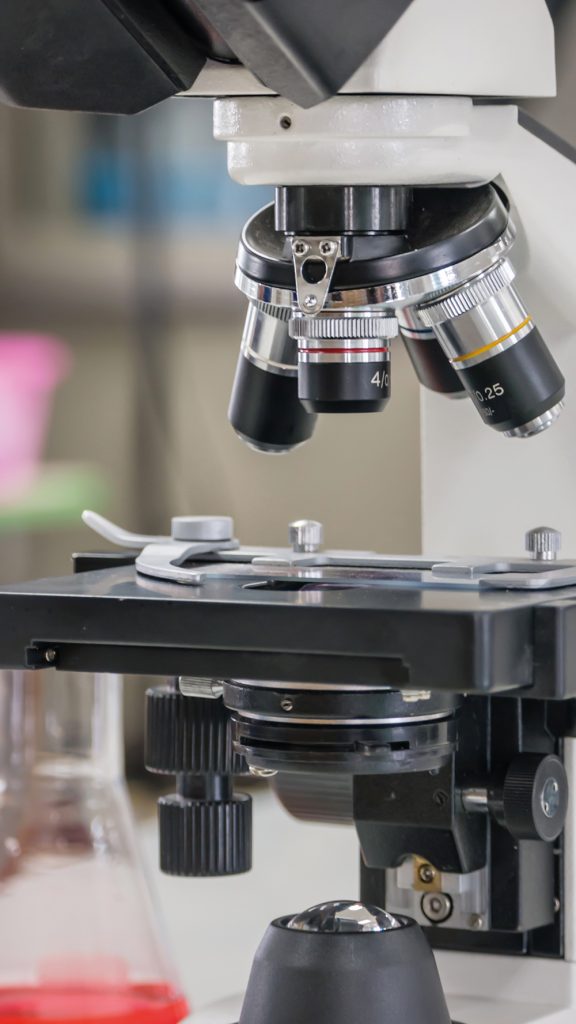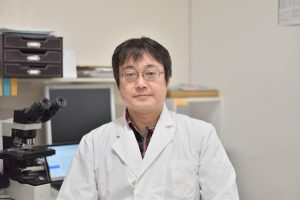Dr Yasuhiro Sakai | Dr Kazuhiko Kuwahara – GANP: An Immunoactive Protein with a Key Role in Tumourigenesis
Investigating the role of an immune system protein, GANP, and its coding gene, ganp, Dr Yasuhiro Sakai and Dr Kazuhiko Kuwahara (Fujita Health University School of Medicine) have unveiled a potential role for this important protein in tumourigenesis. The scientists apply a multidisciplinary approach to identify potential therapeutic solutions to aid cancer prognosis, a collaboration that occurs in the emerging field of immunopathology. The researchers focus on the differential levels of GANP which appear to correlate with breast cancers (low GANP) and with lymphocytic cancers (high GANP).
Germinal Centre-Associated Nuclear Protein (GANP)
First discovered in 2000 by Dr Kazuhiko Kuwahara, who now belongs to the Fujita Health University School of Medicine, GANP is vital in human health and is associated with multiple functions across cell biology, neurology, immunohaematology and oncology.
On its identification, GANP was linked to B-cell differentiation and the affinity maturation of germinal centres. Affinity maturation requires the hypermutation of variable region genes and class switching of B-cell receptors, which occurs in response to T-cell dependent antigens, a key immune system process that allows antibody production against a vast array of foreign molecules.
Using immunohistochemical methods, Dr Kuwahara and his colleagues identified a molecule in mice that was upregulated in germinal centres and then applied cloning methodologies to identify the gene. The mouse protein product, GANP, is a large, 1971 amino acid protein, and the human form of the protein is similarly sized at 1980 amino acids.
The human form of GANP shows a high degree of similarity to the original mouse protein, and both exhibit some similarity with other proteins, which are related to the functions of this molecule. In the two decades since its discovery, GANP has been found to extend beyond the humoral immune system, with many functions across the entirety of the body tissues now being attributed to this protein.
Functions of GANP
GANP forms a complex with other proteins to produce TREX-2, which is important in mRNA nuclear export, that is, the transfer of messenger RNA (mRNA) from the cell nucleus to the cytoplasm, where the mRNA molecules direct protein synthesis.
Specifically, GANP is a vital part of the complex, which enables the transfer of nuclear RNA export factor 1 (NXF1) binding messenger ribonucleoproteins (mRNPs) to the nuclear pores that provide a transportation route to the cell cytoplasm.
It is important to note that mRNA export occurs by both a GANP-dependent mechanism and another which is GANP-independent. In some circumstances, GANP is associated with cell death (apoptosis). Dr Kuwahara found that ganp RNA interference (RNAi) in the HeLa cell line resulted in the cell cycle being stopped, an increase in the abnormal alignment of chromosomes and, ultimately, cell death.

Inhibition of Tumourigenesis
In addition to the NXF1 pathway for mRNA export, there is a secondary specialised pathway known as CRM1, and there is discord amongst scientists with regards to the role that dysregulation of mRNA export plays in the initiation of cancer. However, it is clear that dysregulation in the specialised CRM1 system is apparent in a number of cancers, where overexpression of CRM1 is often reported and, of critical importance, the extent of overexpression is linked to the patients’ outcome.
There is building evidence that the bulk export of mRNA, via the NXF1 pathway is also important in cancer initiation, and expression of GANP is frequently altered, either up or down, in cancers.
Increased expression of GANP has been detected in lymphomas (blood cancers) and malignant melanomas (skin cancers), while decreased levels of GANP have been identified in breast cancers and glioblastomas (aggressive cancers of the brain and central nervous system).
GANP and Breast Cancer
Dr Yasuhiro Sakai (also at Fujita Health University School of Medicine) and Dr Kuwahara have studied the biological indicators of breast cancer resulting in cutting-edge findings. The BReast CAncer (BRCA) genes have developed, even within the general population, a strong connection to breast cancer, with mutations in these genes being associated with hereditary cancer of the breast. While screening for the presence of BRCA mutations does assist some potential breast cancer sufferers, the vast majority of breast cancer cases arise sporadically. In other words, there is no family link that can be determined via BRCA screening.
Sporadic breast cancer is a complex condition associated with a myriad of biological processes likely combining to implement its initiation. Dr Sakai and Dr Kuwahara have investigated GANP and how it affects the development of sporadic breast cancers. We know that GANP has an important immunological role. However, the two researchers understand that the role that GANP plays in DNA damage may contribute to the initiation of a number of malignancies, including breast cancer tumourigenesis. Dr Sakai and Dr Kuwahara are combining their specialist areas of tumour pathology and immunology in the quest for clarity in understanding the progression of sporadic tumours and the role of GANP.
Using a mouse model, Dr Sakai and Dr Kuwahara have shown that a deficiency in GANP results in the development of mammary tumours. They note that although there are clear differences between the mouse and human models, this work is a vital step towards a novel therapeutic for breast cancer tumours.
One of the current aims of Dr Sakai and Dr Kuwahara is to determine the molecular processes that result in lowered expression of the ganp gene. It is largely accepted that excess oestrogen plays a key role in carcinogenesis of breast tissue, via damaging cellular DNA. GANP appears to operate as a tumour suppressor in these circumstances, and maintaining the expression of GANP may be pivotal in reducing the DNA damage induced by oestrogen in the breast tissue which results in tumour initiation. It appears that GANP has an antioncogenic effect on breast carcinogenesis.

The Immune System Role of GANP
GANP is well known for its role in B-cell affinity maturation, including somatic hypermutation and double-stranded DNA break formation in the variable regions of antibodies. Somatic hypermutation is the mechanism by which the immune system changes to manage its response to novel antigens.
A further immune system role for GANP is in inducing B-cells to change to macrophages, a process called transdifferentiation or producing a mixed phenotype cell that combines B-cell and macrophage characteristics. This is important in some cancers such as Hodgkin lymphoma which shows a B-cell/macrophage biphenotype and where GANP is overexpressed.
Hodgkin Lymphoma Initiation and GANP
Hodgkin lymphoma is a cancer of the lymphoid system in which B-cells change to larger lymphocytes with altered characteristics. In some cases the B-cells lose their markers and can simultaneously acquire characteristics of macrophages, such as secreting macrophage-specific cytokines (specialised proteins of the immune system) and becoming phagocytic, that is to say, develop the ability to engulf foreign materials.
Dr Sakai and Dr Kuwahara’s work using mouse models shows that GANP regulates the switching process between B-cells and macrophages, and that overexpression of GANP may result in Hodgkin lymphoma, which shows the mixed B-cell/macrophage phenotype.

Development of a Murine Model of Hodgkin Lymphoma
Hodgkin lymphoma is difficult to research from a cellular pathology perspective due to a lack of suitable animal models. While Hodgkin lymphoma is thought to originate from lymphoid germinal centre B-cells, the cellular characteristics of the tumour cells demonstrate the characteristics of both B-cells and macrophages.
In a lyn-deficient mouse model, similar B-cell/macrophage cells have been identified. The lyn gene product is involved in transferring signals from some important B-cell molecules. GANP is a target for lyn-mediated signalling in germinal centre B-cells for the maturation of high affinity antibodies.
Their work shows that GANP has a pivotal role in the B-cell changes which result in the B-cell/macrophage biphenotype that corresponds to Hodgkin lymphoma. Dr Sakai and Dr Kuwahara have identified the putative region of the ganp gene that is targeted by lyn, the PU.1 binding site. Critically, this PU.1 region regulates both B-cell and macrophage differentiation, and consequently, PU.1 may exert control over the reprogramming that occurs to produce the B-cell/macrophage mixed phenotype cells. They found that a low concentration of PU.1 leads the B-cell/macrophage precursor cells down the B-cell pathway, whereas a high concentration of this product promotes macrophage differentiation.
Overexpression of GANP is found in a number of human blood and lymphoid cancers, including cells of Hodgkin lymphoma. This indicates a regulatory role for GANP in the ‘reprogramming’ of B-cells to macrophage-like cells in these cancers, and GANP is detectable in human Hodgkin lymphoma cells.
For the mouse model, the researchers found that Ig-ganp transgenic mice spontaneously develop Hodgkin lymphomas, which show similar properties to human B-cell/macrophage biphenotypic cells, making this novel murine model an excellent option for studying cytopathology of Hodgkin lymphoma.
Future Work
In addition to the well-characterised role in immunohaemotology for GANP, Dr Sakai and Dr Kuwahara have demonstrated a role for GANP in tumourigenesis. Using animal models, some of which they have developed for this purpose, they show that GANP expression is upregulated in some tumours, and that it may play an important role in inducing tumourigenesis.
It is critical to note that, depending on tumour type, GANP may be either up- or downregulated. Given this situation, Dr Sakai and Dr Kuwahara stress the absolute requirement to define the differential effects of GANP on tumourigenesis of blood cell malignancies, where it is overexpressed, and in breast cancer and glioma, where it is underexpressed.
In conclusion, the in-depth analysis of the molecular pathways and interactions of GANP and its regulators by Dr Sakai and Dr Kuwahara has allowed the identification of areas of key interest with the potential to inform future therapeutic options for cancer.
Reference
https://doi.org/10.33548/SCIENTIA592
Meet the researchers

Yasuhiro Sakai, MD, PhD
Senior Assistant Professor
Department of Diagnostic Pathology
Fujita Health University School of Medicine
Dr Yashiro Sakai, a board certified pathologist, completed his MD in 2009 and then undertook a PhD at the Shinshu University Graduate School of Medicine. Upon completion of his PhD, he completed a residency in surgical pathology at the University of Fukui Hospital, and is now a Senior Assistant Professor in the Department of Diagnostic Pathology, Fujita Health University School of Medicine. Dr Sakai has a wide range of interests, including the role of artificial intelligence in pathology. Dr Sakai’s major focus is currently in a collaborative study, incorporating both pathology and immunology, to investigate the role of GANP and associated molecules, with a focus on the molecular and biological pathways that contribute to the regulation of tumourigenesis in haematological and other tumour types.
CONTACT
W: https://researchmap.jp/7000023712?lang=en

Kazuhiko Kuwahara, MD, PhD
Assistant Professor
Department of Diagnostic Pathology
Fujita Health University School of Medicine
Dr Kazuhiko Kuwahara completed his MD in 1989 at the Saga Medical School, and thereafter undertook a series of research positions, culminating in an Assistant Professorship at the Fujita Health University School of Medicine. Dr Kuwahara’s early work focused on immunology research, and he originally identified the protein GANP as a B-cell modulator, which is now the focus for a collaborative tumourigenesis project. The collaborative project has shown that GANP is both up- and down-regulated in various cancers, and the focus of the work is now investigating the balance necessary to aid in the treatment of breast cancer while ensuring that lymphocytic cancers are not induced.
CONTACT
W: https://researchmap.jp/read0068817?lang=en
FURTHER READING
Y Sakai, S Phimsen, S Okada, K Kuwahara, The critical role of germinal center-associated nuclear protein in cell biology, immunohematology, and hematolymphoid oncogenesis, Experimental Hematology, 2020, 90, 30–38.
Y Sakai, A Rezano, S Okada, et al, A novel cytological model of B-cell/macrophage biphenotypic cell Hodgkin lymphoma in ganp-transgenic mice, Cancers, 2020, 12, 204.
S Fujimura, Y Xing, M Takeya, et al, Increased expression of germinal center-associated nuclear protein RNA-primase is associated with lymphomagenesis, Cancer Research, 2005, 65, 5925–5934.
![]()
Want to republish our articles?
We encourage all formats of sharing and republishing of our articles. Whether you want to host on your website, publication or blog, we welcome this. Find out more
Creative Commons Licence
(CC BY 4.0)
This work is licensed under a Creative Commons Attribution 4.0 International License. 
What does this mean?
Share: You can copy and redistribute the material in any medium or format
Adapt: You can change, and build upon the material for any purpose, even commercially.
Credit: You must give appropriate credit, provide a link to the license, and indicate if changes were made.
More articles you may like
Grandmothers: Innovation Through Tradition
Grandmother Project – Change through Culture (GMP) is an organisation dedicated to documenting the role of grandmothers and demonstrating the effectiveness of grandmother-inclusive strategies in improving the health and well-being of women, children, and adolescents. GMP’s groundbreaking work challenges conventional wisdom to transform community-based interventions in Africa and beyond, harnessing a powerful but often overlooked resource: the wisdom and influence of grandmothers.
Dr Robert Larkin | Cultivating Change to Improve Soil Health and Increase Potato Yield
Environmental quality and food production are facing the pressing challenges of climate change and global population growth. Dr Robert Larkin from the United States Department of Agriculture-Agricultural Research Service (USDA-ARS) and a team of plant scientists developed and tested a range of crop management systems to help overcome these compounding challenges. Their work is improving soil health and increasing the yield of potato crops, contributing to the future food security of nations.
Professor Giorgio Buttazzo | Artificial Intelligence and a Crossroads for Humanity
Where do we stand with artificial intelligence? Might machines take over our jobs? Can machines become conscious? Might we be harmed by robots? What is the future of humanity? Professor Giorgio Buttazzo of Scuola Superiore Sant’Anna is an expert in artificial intelligence and neural networks. In a recent publication, he provides considered insights into some of the most pressing questions surrounding artificial intelligence and humanity.
Dr Ralf Adam | New Technologies Shaping the Future of Oral Hygiene
Understanding the efficiency of various toothbrush technologies is essential for achieving optimal oral health. Dr Ralf Adam, who leads a dedicated team at Procter & Gamble in Germany, is keen to investigate the complexities of these technologies. His team have provided new insights into the best toothbrush types for plaque removal and the maintenance of gum health. By highlighting the importance of informed oral care decisions and ongoing investigations, this vital research works towards ensuring everyone can achieve a brighter, healthier smile.




